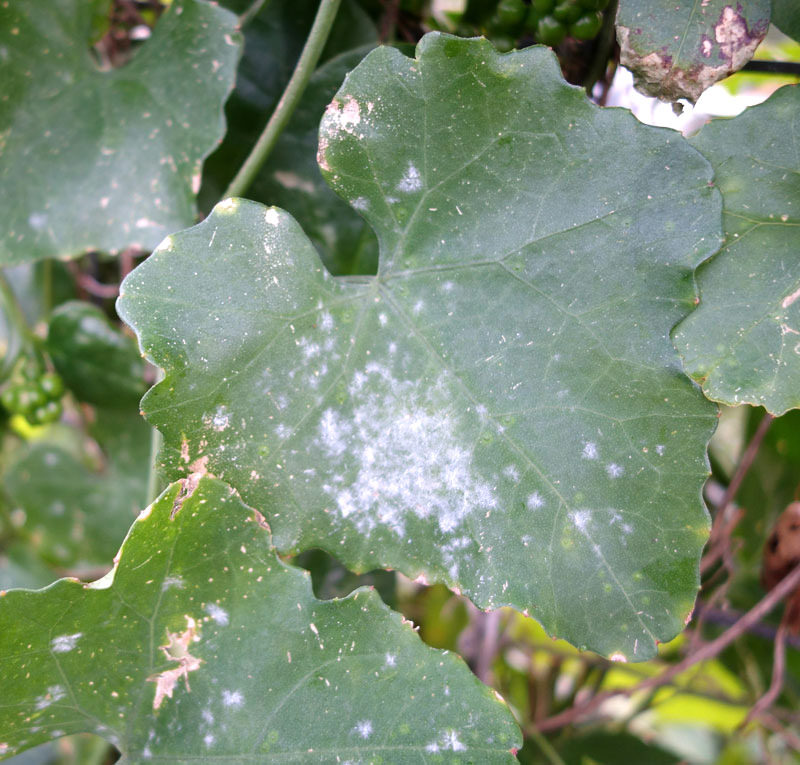The name powdery mildew is given to various species of fungi that infect a wide range of plants, including beans, beets, carrots, cucumbers, lettuce, melons, peas, radishes, tomatoes and turnips, among others. Although this disease doesn’t usually kill its hosts, it weakens them, often distorting and yellowing leaves, affecting yield and sometimes flavor.
Spot It

The only good news about powdery mildew is that it isn’t hard to identify. Powdery mildew usually shows up as whitish patches of powder-like growth, most commonly found on the upper sides of leaves. Although it primarily attacks tender young growth, all above-ground parts of the plant can be infected. Powdery mildew is sometimes confused with another garden scourge, downy mildew. However, downy mildew is caused by organisms more closely related to algae than fungi, requires different growing conditions, causes different lesions, and doesn’t have a powdery appearance.
The various strains of powdery mildew that attack and proliferate on vegetables
thrive in hot, dry climates and require humidity for spore germination. Being fungi, they need only air movement to spread spores from plant to plant. According to the Penn State Extension, the ideal growth conditions for powdery mildew are:
- temperatures between 70 and 90 degrees F
- high nighttime humidity
- low daytime humidity
Water doesn’t need to be present for powdery mildew to occur, according to the Colorado State University Extension—in fact, it doesn’t even occur on wet leaves. Powdery mildew germinates when relative humidity reaches 90 percent or above, which can occur in areas of poor air circulation, damp and shaded areas, or crowded plantings.
Powdery mildew can overwinter in several ways, depending on the species of fungi and host plant. In areas where the plant produces leaves year-round, the spores will survive in even less-than-optimal temperatures. Without a live host, they adopt a related plant that remains green.
Powdery mildew also makes it from one season to the next by producing mycelium, tiny spore-containing structures. According to the Department of Plant Pathology and Ecology at the Connecticut Agricultural Experiment Station, these mycelium are initially white, maturing to yellow-brown and finally black, appearing almost pepper-like. In this form, the fungi overwinter on dead plants, and then when new plant growth begins and temperatures and humidity are favorable, the “stored” spores become active.
Stop the Spread
The first line of defense for controlling powdery mildew is to choose genetically resistant plant species. Next, do routine checks to catch any infestation before it becomes advanced. You can also take these other preventative measures:
- Avoid overhead watering to reduce relative humidity.
- Avoid fertilizing in late summer to limit new growth.
- Prune overcrowded areas to increase air circulation and reduce humidity
- Remove infected plants and debris, and throw away. Do not compost infected debris, as it might not get hot enough to kill spores and could spread the disease.
In addition to these cultural controls, you might need to use topical chemical treatments to stop powdery mildew’s spread. Some products are protectant only, applied to susceptible plants as a preventative measure, while others help eradicate powdery mildew. In either case, all plant surfaces must be covered. Follow label instructions for maximum effectiveness and safety.
The University of California Davis Integrated Pest Program gives a list of least-toxic fungicides used on powdery mildew:
- Sulfur products have been used for centuries to help control powdery mildew, but are only effective before the disease appears. Sulfur can damage some cultivars. In addition, it needs to be applied in temperatures lower than 90 degrees F and at least two weeks after using an oil spray.
- Horticultural oils, neem oil and jojoba oil work to eradicate mild to heavy infections of powdery mildew. However, to avoid injuring your plants, never apply if plants are water-stressed, when temperatures are above 90 degrees, or within two weeks of using a sulfur spray.
- Bicarbonates, including baking soda, can help prevent and eradicate powdery mildew. Baking soda (sodium bicarbonate) is said to be one of the most effective homemade remedies, but bicarbonate sprays can also injure plants, so use carefully.
- Biological fungicides containing active ingredient Bacillus subtilis or Trichoderma harziannum are mainly preventative. They can be somewhat helpful as eradicants, though not as effective as oils.
- Synthetic fungicides are available and function as both eradicant and protectant against powdery mildew.
Resistant cultivars along with good management and appropriate fungicides can help avoid or eradicate stubborn powdery mildew and keep your growing season green.





One reply on “Beginning Farmer’s Guide to Powdery Mildew”
[…] pathogens can be pretty confusing for home gardeners. For example, downy mildew and powdery mildew are two plant diseases that are often mixed up, and thus ineffectively treated. Unlike powdery […]